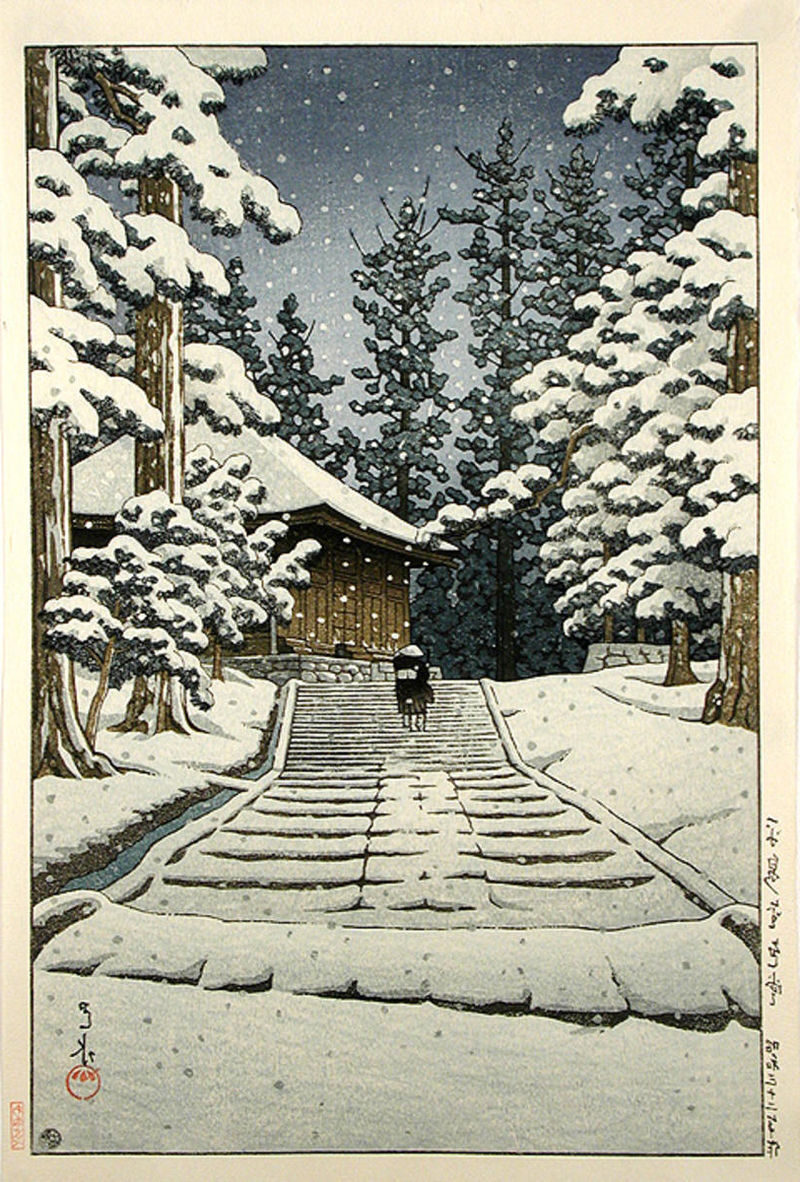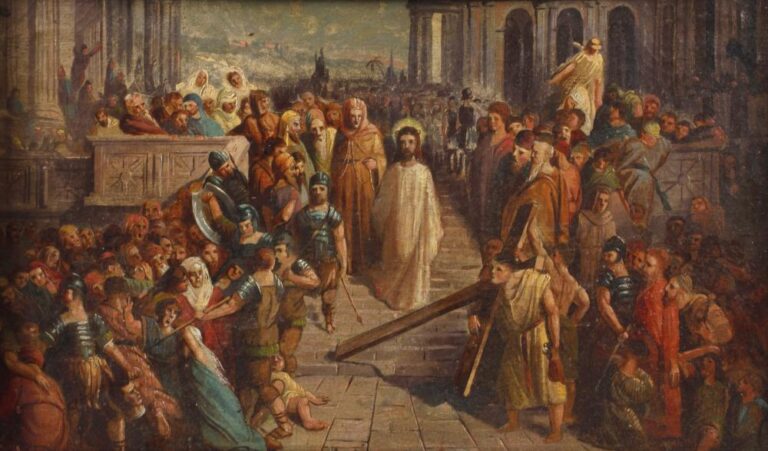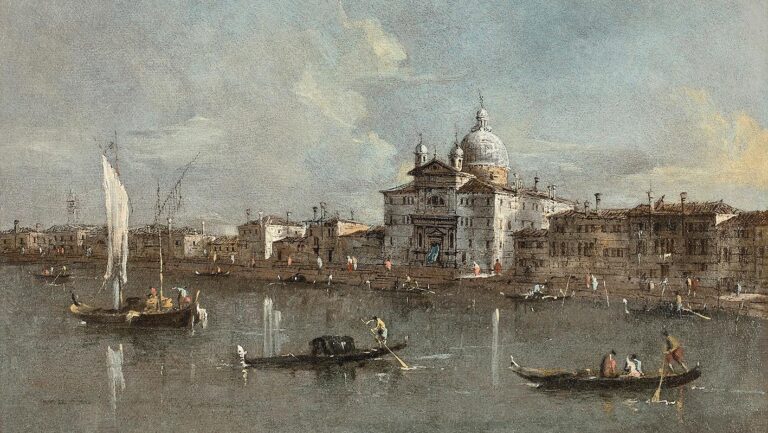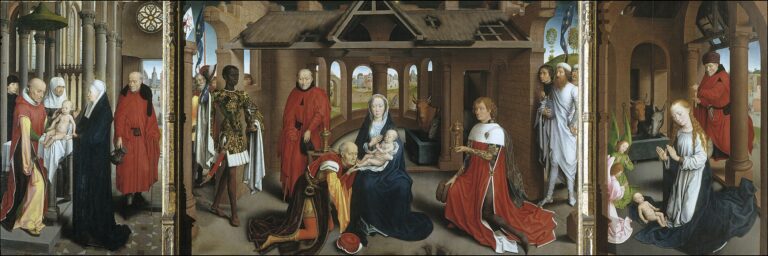Hasui Kawase Artwork: Exploring Timeless Japanese Landscapes
Born: May 18, 1883; Japan
Death: November 7, 1957; Japan
Art Movement: Taishō period (1912–1926)
Nationality: Japanese
Influenced By: Okada Saburōsuke, Kiyokata Kaburagi, and Shōzaburō Watanabe
Institution: The Art Institute of Chicago, the Clark Art Institute, and the Virginia Museum of Fine Arts
Hasui Kawase Artwork: Exploring Timeless Japanese Landscapes
The Life and Legacy of Hasui Kawase
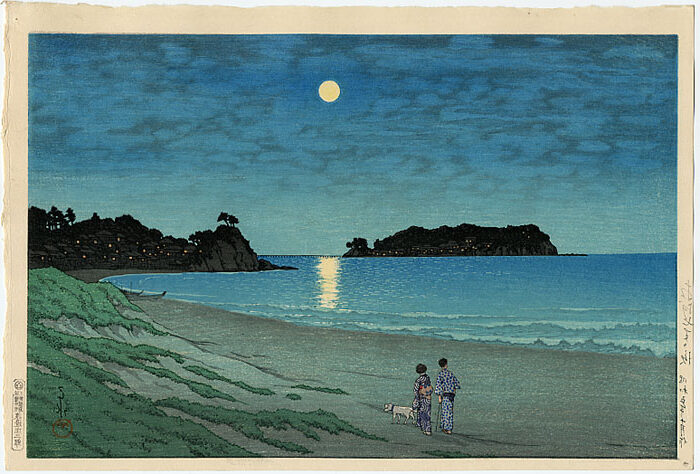
Shichirigahama, Soshu (1930) by Hasui
Hasui Kawase was a renowned figure in the shin-hanga movement. He created over 600 prints that beautifully depicted traditional Japanese landscapes and cityscapes. His work remains highly regarded for its intricate detail and cultural significance.
Biography of Hasui Kawase
Born in 1883 in Japan, Hasui Kawase became a pivotal artist in the 20th-century Japanese art scene. He showed an early interest in art, leading him to study with prominent artist Kiyokata Kaburagi. Influenced by Western-style painting, Hasui blended traditional ukiyo-e techniques with new artistic methods.
During his prolific career, he crafted scenes reflecting the serene beauty of Japan’s landscapes. His travels across the country provided inspiration for his art. Despite facing health challenges, Hasui continued creating art until his passing in 1957 at the age of 74 in Tokyo, Japan.
Notable Achievements and Honors
Hasui Kawase has left an indelible mark on the world of art. He played a significant role in the shin-hanga movement, recognized for his ability to merge cultural themes with modern techniques.
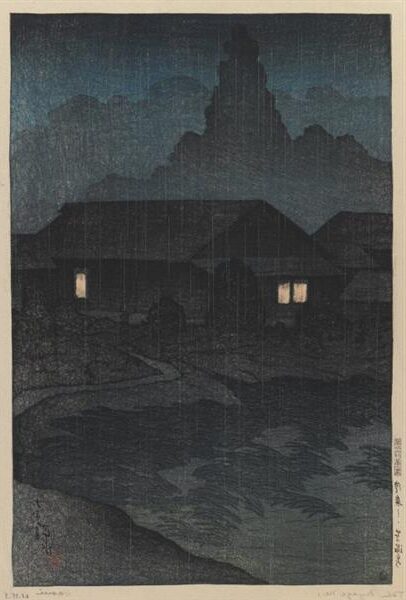

His print series earned him international acclaim, with many collectors valuing his work highly. In 1956, he was named a “Living National Treasure,” an honor celebrating his contributions to Japanese culture. His final piece, “Hall of the Golden Hue, Hiraizumi,” completed during his battle with cancer, exemplifies his enduring commitment to art.
Works and Artistic Style
Kawase Hasui is celebrated for his masterful woodblock prints that capture the essence of Japan’s landscapes. His art is a marriage of traditional Japanese scenes with influences from Western art.
Shin-Hanga and Ukiyo-E Influence
Kawase Hasui played a pivotal role in the Shin-Hanga movement, which revitalized the traditional Ukiyo-E style. This movement emphasized the collaboration between artists, carvers, and printers.

Tokyo 12 Dai Komatogashi (1919) by Hasui Kawase
Hasui’s work stood out due to the use of vibrant colors and innovative compositions. His adoption of Western techniques, such as perspective and shading, added depth to his prints.
Unlike traditional Ukiyo-E, which often depicted figures, Hasui focused on tranquil landscapes and urban scenes, reflecting the beauty and transience of nature.
Key Themes and Subjects
Hasui’s artwork commonly features serene landscapes, cityscapes, and rural scenes. He had a particular affection for Japanese shrines, temples, and natural settings like mountains and rivers.
His series, “Twenty Views of Tokyo” and “Souvenirs of Travel,” showcase these landscapes and are renowned for their ability to evoke a sense of calm.
Hasui’s prints often portray the changing seasons, capturing light and atmosphere uniquely. Snow-covered cities and autumnal forests are recurrent subjects, each print inviting the viewer into a moment frozen in time.
Noteworthy Collections and Exhibitions
Hasui’s work has been exhibited in prestigious museums worldwide.
Notable collections can be found in institutions like the British Museum, Metropolitan Museum of Art, and the Museum of Fine Arts in Boston.
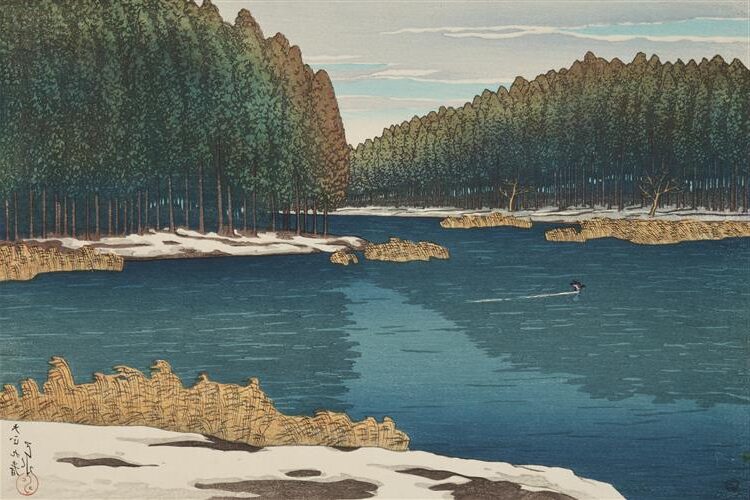
Remaining Snow at Inokashira (1920) by Hasui Kawase
Other museums, such as the Toledo Museum of Art, Brooklyn Museum, and Portland Art Museum, also hold significant Hasui pieces.
His prints are celebrated for their technical excellence and are regularly displayed in exhibitions across the globe. These exhibits provide insight into Hasui’s artistic journey and the lasting impact of his work on the world of Japanese art.
Techniques and Methodologies
Kawase Hasui, a renowned print designer, masterfully combined traditional Japanese woodblock print techniques with contemporary influences. He embraced elements from both Japanese styles and Western-style painting to develop a unique and evocative art style. This blend of techniques allowed him to create a distinct and emotive body of work.
Woodblock Print Process
Hasui’s woodblock print process relied heavily on the traditional methods established during the Edo period.
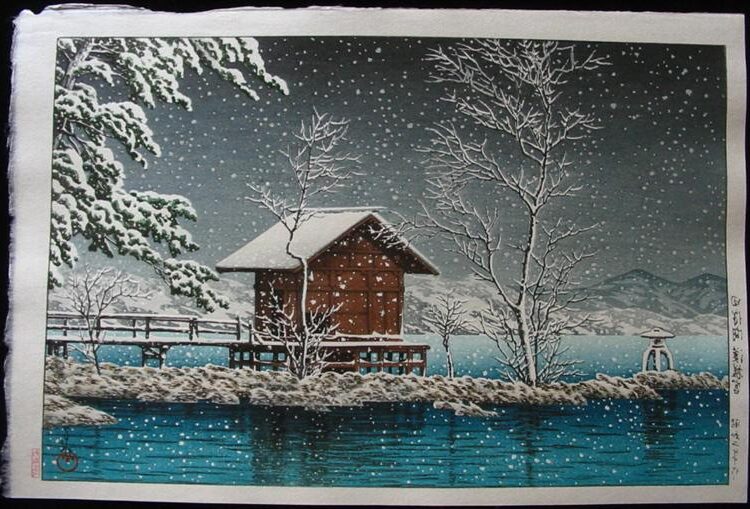
Kansau Shrine in Snow at Lake Tazawa (1927) by Hasui
Printmaker collaboration was vital, with artists, carvers, printers, and publishers working together. They followed a meticulous process, starting with the artist drawing the initial design.
Each print went through multiple stages, including carving wooden blocks for each color, meticulously aligning them for accurate color application. This painstaking labor resulted in detailed, full-color images.
Hasui’s expertise lay in capturing delicate landscapes, focusing on snowscapes and the changing seasons, which made his prints instantly recognizable.
Traditional techniques, such as ukiyo-e, were prevalent in his work but enhanced by his innovative perspectives. This allowed him to capture intricate details that were true to Japanese aesthetics, while also appearing refreshingly modern to contemporary audiences.
Influences from Western-Style Painting
Hasui’s work exhibited a significant influence from Western-style painting.
He often incorporated elements such as linear perspective, learned from Western art, to add depth to his landscapes. This influence helped create a sense of realism in his prints that differed from traditional Japanese depictions.
While remaining rooted in nihonga (Japanese style painting), Hasui explored Western techniques found in oil paintings and other formats.
He skillfully blended these influences to develop a distinct visual language, marked by light and shadow play. This approach allowed his work to resonate with a broader audience, bridging Eastern and Western art traditions.
Through this fusion, Hasui managed to create pieces that maintained their Japanese identity while pushing boundaries, reflecting modern Japan’s ever-evolving culture.
Cultural Impact and Influence
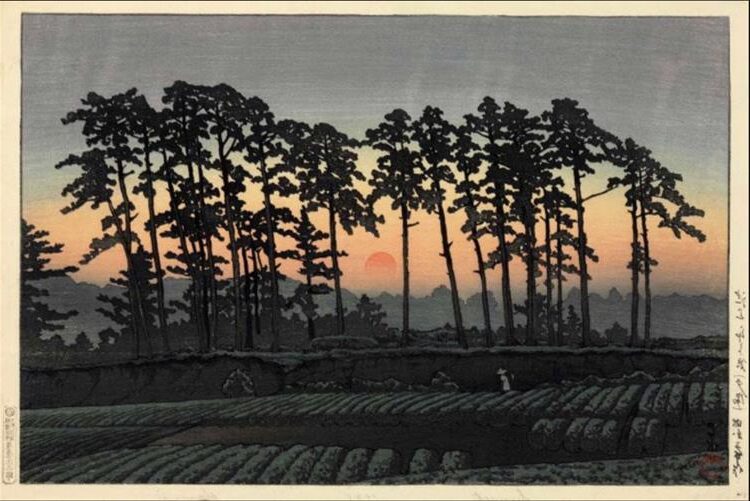
Sunset at Ichinokura (1928) by Hasui Kawase
Hasui Kawase was instrumental in shaping the Shin Hanga movement, blending traditional Japanese techniques with modern styles. His work during the Showa Period and his interactions with other artists solidified his place in art history.
Hasui Kawase’s Influence on Other Artists
Hasui Kawase inspired many artists with his detailed landscapes and townscapes. Figures such as Ito Shinsui and Shinsui Itō were influenced by his combination of modernity and tradition.
Kawase’s collaboration with print designers made his work widely accessible. His detailed townscape prints resonated with the work of Hiroshige and influenced Kiyokata Kaburagi, who gave Hasui his name.
His meticulous depictions of places like the Zojo Temple highlighted his realist approach. His contribution to Shin Hanga helped revive traditional artwork, ensuring its place in global art through his series like Twelve Scenes of Tokyo.
His Role in the Showa Period and Beyond
During the Showa Period, Hasui Kawase’s art captured the essence of Japan, blending old and new. After the Great Kantō Earthquake, he depicted changing landscapes with an eye for traditional subjects, such as delicate townscapes, often seen in his prints.
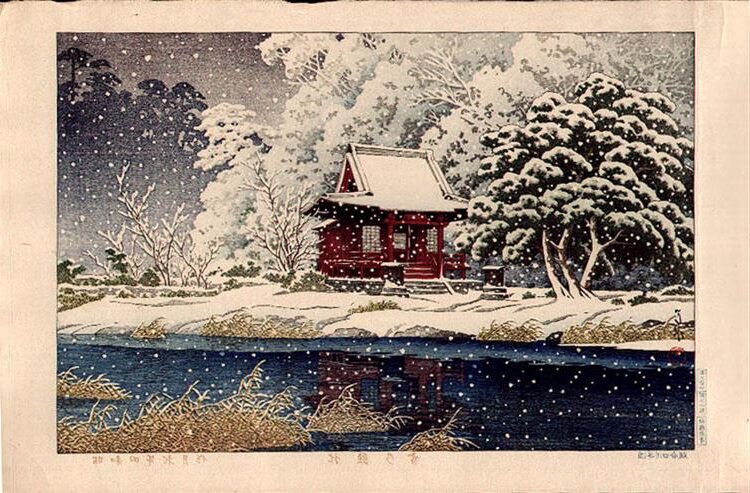
Snowy Inokashira, Benten (1929) by Hasui Kawase
His role extended beyond mere art creation; he participated in cultural preservation, similar to figures like Katsushika Hokusai. Although not accorded the title of Japanese Living National Treasure, his influence paralleled those who were.
Okada Saburōsuke’s guidance early in his career also helped him develop a unique style that left lasting impressions on both contemporary and later artists. Through his works, the magic of old Japan continues to draw admiration.
Frequently Asked Questions
Kawase Hasui was a Japanese artist known for his woodblock prints, often depicting landscapes. His work is sought after for its artistic and historical value. Many people are curious about how to identify, value, and purchase his prints.
How can one distinguish an original Kawase Hasui print from reproductions?
Original Kawase Hasui prints often have specific characteristics, such as a publisher’s seal and signature. The paper quality and color application also indicate authenticity. Reproductions may lack these details and often appear newer.
What factors affect the value of Kawase Hasui’s original artwork?
Several factors can impact the value of his artwork, including its condition, rarity, and historical significance. Prints with well-preserved colors and minimal damage are typically more valuable. Provenance and limited editions also play a role.
Where can one purchase authentic Kawase Hasui woodblock prints?
Authentic Kawase Hasui woodblock prints can be found at reputable art galleries, auction houses, and online marketplaces specializing in Japanese art. It’s important to verify the seller’s credibility before making a purchase.
How has Kawase Hasui’s work influenced modern Japanese media or other art forms?
Kawase Hasui’s work has influenced modern Japanese media through its vivid landscapes and traditional techniques. These elements are echoed in contemporary film, animation, and graphic design, showcasing a blend of tradition and modernity.
Can Kawase Hasui’s artwork be used freely due to public domain status?
Kawase Hasui’s artwork may be in the public domain, as he passed away in 1957. However, it’s crucial to confirm each piece’s status, as usage rights can vary by country depending on copyright laws.
What are the characteristics of Kawase Hasui’s technique in creating his prints?
Kawase Hasui’s technique is characterized by a focus on light, shadow, and natural landscapes. He combined traditional Japanese styles with Western influences. This created prints with realistic atmospheres and unique compositions. These prints are both serene and detailed.



